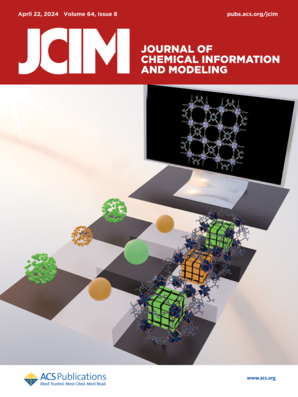Navigating Ultralarge Virtual Chemical Spaces with Product-of-Experts Chemical Language Models
IF 5.6
2区 化学
Q1 CHEMISTRY, MEDICINAL
引用次数: 0
Abstract
Ultralarge virtual chemical spaces have emerged as a valuable resource for drug discovery, providing access to billions of make-on-demand compounds with high synthetic success rates. Chemical language models can potentially accelerate the exploration of these vast spaces through direct compound generation. However, existing models are not designed to navigate specific virtual chemical spaces and often overlook synthetic accessibility. To address this gap, we introduce product-of-experts (PoE) chemical language models, a modular and scalable approach to navigating ultralarge virtual chemical spaces. This method allows for controlled compound generation within a desired chemical space by combining a prior model pretrained on the target space with expert and anti-expert models fine-tuned using external property-specific data sets. We demonstrate that the PoE chemical language model can generate compounds with desirable properties, such as those that favorably dock to dopamine receptor D2 (DRD2) and are predicted to cross the blood–brain barrier (BBB), while ensuring that the majority of generated compounds are present within the target chemical space. Our results highlight the potential of chemical language models for navigating ultralarge virtual chemical spaces, and we anticipate that this study will motivate further research in this direction. The source code and data are freely available at https://github.com/shuyana/poeclm.

利用专家产品化学语言模型导航超大型虚拟化学空间
超大虚拟化学空间已成为药物发现的宝贵资源,可提供数十亿种按需制造的化合物,且合成成功率高。化学语言模型可以通过直接生成化合物来加速对这些巨大空间的探索。然而,现有的模型并不是为浏览特定的虚拟化学空间而设计的,往往忽略了合成的可及性。为了弥补这一不足,我们引入了专家产品(PoE)化学语言模型,这是一种导航超大虚拟化学空间的模块化可扩展方法。这种方法通过将在目标空间预训练的先验模型与利用外部特定属性数据集微调的专家和反专家模型相结合,在所需的化学空间内可控地生成化合物。我们证明,PoE 化学语言模型可以生成具有理想特性的化合物,如能与多巴胺受体 D2(DRD2)良好对接并预测能穿过血脑屏障(BBB)的化合物,同时确保生成的大多数化合物都在目标化学空间内。我们的研究结果凸显了化学语言模型在导航超大虚拟化学空间方面的潜力,我们预计这项研究将推动这方面的进一步研究。源代码和数据可在 https://github.com/shuyana/poeclm 免费获取。
本文章由计算机程序翻译,如有差异,请以英文原文为准。
求助全文
约1分钟内获得全文
求助全文
来源期刊
CiteScore
9.80
自引率
10.70%
发文量
529
审稿时长
1.4 months
期刊介绍:
The Journal of Chemical Information and Modeling publishes papers reporting new methodology and/or important applications in the fields of chemical informatics and molecular modeling. Specific topics include the representation and computer-based searching of chemical databases, molecular modeling, computer-aided molecular design of new materials, catalysts, or ligands, development of new computational methods or efficient algorithms for chemical software, and biopharmaceutical chemistry including analyses of biological activity and other issues related to drug discovery.
Astute chemists, computer scientists, and information specialists look to this monthly’s insightful research studies, programming innovations, and software reviews to keep current with advances in this integral, multidisciplinary field.
As a subscriber you’ll stay abreast of database search systems, use of graph theory in chemical problems, substructure search systems, pattern recognition and clustering, analysis of chemical and physical data, molecular modeling, graphics and natural language interfaces, bibliometric and citation analysis, and synthesis design and reactions databases.

 求助内容:
求助内容: 应助结果提醒方式:
应助结果提醒方式:


